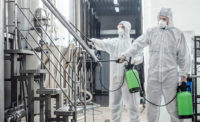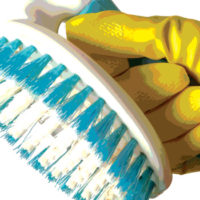Designing Conveyors for Sanitation Success

In any hygienic industry, the importance of conveyor belt cleaning and sanitation cannot be exaggerated. At the very least, inadequate cleaning can delay startup; in the worst cases, it can lead to costly shutdowns or product recalls. Not surprisingly, then, the belt sanitation support a plant receives can dramatically affect productivity and costs. With the right support, food processors can prevent cleaning and sanitation problems; increase cleaning effectiveness; meet or exceed strict sanitation requirements; and reduce sanitation-related costs without sacrificing hygiene standards.
Gary Larsen, Technical Support Director for Hygienic Services, with Intralox Inc., the world's largest, exclusive manufacturer of modular plastic conveyor belts, leads the company's global Clean Team, which provides recommendations and assistance based on years of combined experience in food industry sanitation, belt engineering, conveyor design and cleaning chemical research. He notes that the most critical consideration in sanitation problem prevention is conveyor design.
"Although the proper cleaning methods and materials are vital components of any sanitation regime, conveyor and belt design can ultimately determine a plant's success or failure in preventing conveyor sanitation problems," says Larsen. "The number one sanitation problem plaguing plants today is restricted cleaning access caused by closed conveyor designs. Even the most 'cleanable' belt will be more difficult to clean if it's installed on a conveyor with a closed design. Basically, if you can't reach an area of the belt, you can't clean it."
Larsen adds that the Intralox Clean Team not only works with plants to solve recognized cleaning and sanitation problems, they offer guidelines and group seminars that advise on sanitation-friendly conveyor design elements like cleanable carryways, and low belt tension configurations for improved cleaning access. "Many food plants have old conveyor technology and getting that technology changed over and updated to meet sanitation goals is a long process," he says. "We've found that 80% of a food plant's cleaning time isn't spent on the belts, but on the conveyor itself, which makes the proper design of the conveyor from the outset a critical component of successful sanitation efforts."
New & Proven Easy-Clean Belt Designs
"Easy-clean" belt and conveyor designs enable plants to achieve more consistent cleaning and sanitation results: they act as helpful constants in a process typically hampered by variables like sanitation crew turnover, chemical mixing errors, and so on. For instance, says Larsen, field performance shows that Intralox's exclusive Cam-link hinge design reduces cleaning time and water usage by allowing water to pass through more easily. The Olympig pork slaughtery in Josselin, Brittany (France) reported that Intralox's EZ Clean Series 800 Open Hinge Flat Top belt reduced their belt cleaning time by 65% and water usage by 20%-30%.
In high-impact applications like evisceration lines and boning tables easy-clean belts also can make a big difference. At AIBP Cahir in Ireland, Quality Assurance Manager Noel Doyle says, "Our swab tests indicated zero pathogens and the lowest possible rating you can get by swab tests since we installed the Intralox EZ Clean Flat Top belts in our boning hall 10 months ago," he says. "Overall, the Series 1800 Flat Top and Series 800 Open Hinge Flat Top belts have made it much easier to achieve the high sanitation standards we've always set for ourselves." Boning Hall Manager Alan Harris adds, "The Intralox belts are much easier to clean than our flat belts, and cleaning is 30%-50% faster, depending on the belt and application."
Belts in the value-added processing area often pose tough cleaning considerations. In breading or coating applications, for instance, the open grid or flush grid belts required for drainage of the coatings can be particularly susceptible to debris retention. Intralox's Series 1500 Flush Grid belt, designed for small-pitch drainage applications, combats this tendency with special features that remove debris and increase cleaning access to all areas.
Larsen adds that eliminating wire belt problems without reducing cleaning and sanitation effectiveness also is important when considering system design. At a frozen food plant in the UK, wire belt breakage on a formed poultry products line caused 20 hours of downtime per month, increased the risk of product contamination and raised the specter of operator safety issues. Retrofitting the wire belt conveyors with Intralox's Series 1500 Flush Grid belt eliminated the downtime and safety problems while maintaining the plant's high sanitation standards.
Hygienic Belt Testing
It's also important for easy-clean belt designs to be thoroughly tested to validate or improve their sanitation-friendly features, says Larsen. Intralox has a wet test facility dedicated exclusively to the scientific testing of plastic belt cleaning procedures and comparative testing of plastic and other belt technologies. The lab measures a number of cleanability factors, including water flow, cleaning time needed and water usage required, in order to project how belts will increase sanitation success in a working plant environment and helps Intralox fine-tune new hygienic belt designs.
But innovation in belt design is only as good as the conveyor design, states Larsen. "Ultimately, the best conveyor belt design can be defeated by a mediocre design of the conveyor itself, so the operator has to do that part right."
intralox.com
Looking for a reprint of this article?
From high-res PDFs to custom plaques, order your copy today!









